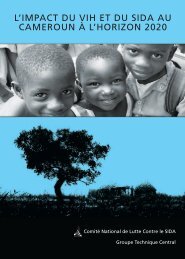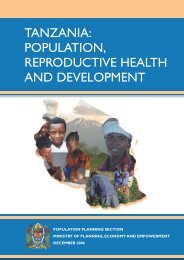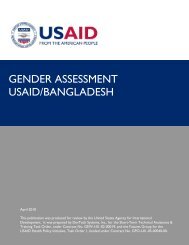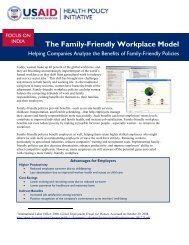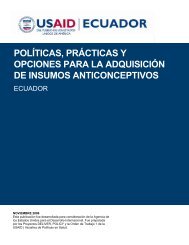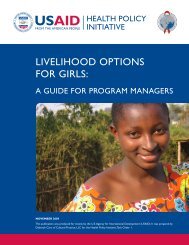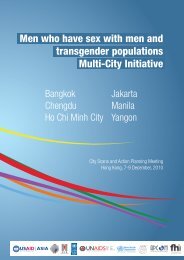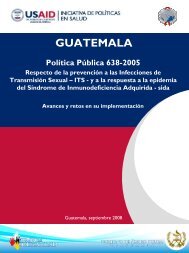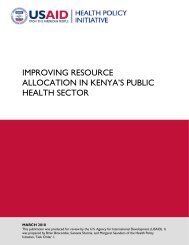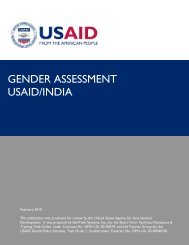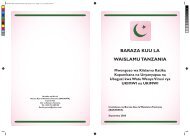INDONESIA HIV/AIDS STRATEGY AUDIT - Health Policy Initiative
INDONESIA HIV/AIDS STRATEGY AUDIT - Health Policy Initiative
INDONESIA HIV/AIDS STRATEGY AUDIT - Health Policy Initiative
Create successful ePaper yourself
Turn your PDF publications into a flip-book with our unique Google optimized e-Paper software.
<strong>INDONESIA</strong> <strong>HIV</strong>/<strong>AIDS</strong><strong>STRATEGY</strong> <strong>AUDIT</strong>JANUARY 2007This publication was produced for review by the U.S. Agency for International Development(USAID). It was prepared by the USAID | <strong>Health</strong> <strong>Policy</strong> <strong>Initiative</strong>, Task Order 1.
The USAID | <strong>Health</strong> <strong>Policy</strong> <strong>Initiative</strong>, Task Order 1, is funded by the U.S. Agency for InternationalDevelopment (USAID) under Contract No. GPO-I-01-05-00040-00, beginning September 30, 2005. <strong>HIV</strong>relatedactivities of the initiative are supported by the President’s Emergency Plan for <strong>AIDS</strong> Relief. TaskOrder 1 is implemented by Constella Futures, in collaboration with the Centre for Development andPopulation Activities (CEDPA), White Ribbon Alliance for Safe Motherhood (WRA), Futures Institute, andReligions for Peace.
<strong>INDONESIA</strong> <strong>HIV</strong>/<strong>AIDS</strong><strong>STRATEGY</strong> <strong>AUDIT</strong>The author’s views expressed in this publication do not necessarily reflect the views of the U.S.Agency for International Development or the U.S. Government.
TABLE OF CONTENTSACKNOWLEDGMENTS ...........................................................................................................................iiiABBREVIATIONS .....................................................................................................................................ivI. INTRODUCTION ...........................................................................................................................1II.III.THE LEGISLATIVE PROCESS IN <strong>INDONESIA</strong>.........................................................................2OVERARCHING <strong>HIV</strong> POLICIES..................................................................................................5IV. <strong>AUDIT</strong> OF THE NATIONAL <strong>STRATEGY</strong> AND RELATED POLICIES ...................................8Prevention..................................................................................................................................8Counseling and Testing...........................................................................................................11Care, Treatment, and Support..................................................................................................12Orphans and Vulnerable Children...........................................................................................13Laboratories.............................................................................................................................13Other: <strong>Policy</strong> Analysis and Systems Strengthening ................................................................14V. CONCLUSION..............................................................................................................................16ii
ACKNOWLEDGMENTSThis document was prepared by staff of the USAID | <strong>Health</strong> <strong>Policy</strong> <strong>Initiative</strong>, Task Order 1. It describesthe current policy environment in Indonesia, and how that environment may support the frameworkoutlined under the U.S. President’s Emergency Plan for <strong>AIDS</strong> Relief. We thank the following groups:• The USAID/Indonesia Mission for its guidance and ongoing support during the audit ofIndonesia’s National <strong>HIV</strong>/<strong>AIDS</strong> Strategy.• Staff from the FHI/ASA project, who provided valuable insight and practical experience fromdirect <strong>HIV</strong> prevention implementation efforts in Indonesia.• The KPA for their support during the development of this document.• The <strong>Health</strong> <strong>Policy</strong> <strong>Initiative</strong>, Task Order 1 staff and consultants involved in the development ofthis document: Dr. Kai Spratt, Ms. Nadia Carvalho, Dr. Claudia Surjadjaja, and Dr. Izhar Fihir.iii
ABBREVIATIONS<strong>AIDS</strong>ARVBKKBNCBOCDCCSTDPDDPR<strong>HIV</strong>IDUIECIFPPDIHPCPIRCMOUNPCIOIPEPFARPL<strong>HIV</strong>PMTCTSTITBUNGASSUSAIDVCTWHOacquired immune deficiency syndromeantiretroviralNational Family Planning Boardcommunity-based organizationCenter for Disease Controlcare, support, and treatmentDewan Perwakilan DaerahDewan Perwakilan Rakyathuman immunodeficiency virusinjecting drug userinformation, education, and communicationIndonesian Forum of Parliamentarians on Population and DevelopmentIndonesia <strong>HIV</strong>/<strong>AIDS</strong> Prevention and Care ProjectIndonesian Red Crossmemorandum of understandingNational <strong>Policy</strong> Composite Indexopportunistic infectionPresident’s Emergency Plan for <strong>AIDS</strong> Reliefpeople living with <strong>HIV</strong>prevention of mother-to-child transmissionsexually transmitted infectiontuberculosisUnited Nations General Assembly Special Session on <strong>HIV</strong>/<strong>AIDS</strong>U.S. Agency for International Developmentvoluntary counseling and testingWorld <strong>Health</strong> Organizationiv
I. INTRODUCTIONIn 2005, Indonesia was home to an estimated 170,000 people living with <strong>HIV</strong> (PL<strong>HIV</strong>). 1 While thecountry’s adult <strong>HIV</strong> prevalence rate is less than 1 percent, higher prevalence rates have been documentedin the most at-risk populations, such as injecting drugs users (IDUs) and sex workers. 2 The strength ofIndonesia’s <strong>HIV</strong>-related policy environment will play a key role in ensuring that the country can avertfuture infections and provide treatment and care for those affected by the <strong>HIV</strong> epidemic. The policyenvironment provides the foundation and mechanisms through which effective, accessible programs andservices can be established, implemented, and sustained over time.To assist in improving the <strong>HIV</strong> policy environment, this audit evaluates Indonesia’s National <strong>HIV</strong>/<strong>AIDS</strong>Strategy and other related prevention, care, and treatment guidelines and regulations. In particular, tohelp inform USAID’s <strong>HIV</strong>-related technical and financial assistance in Indonesia, the audit describes thecurrent policy environment in Indonesia and how that environment may support the framework outlinedunder the U.S. President’s Emergency Plan for <strong>AIDS</strong> Relief (PEPFAR). Section II of this paper presentsan overview of the legislative process in Indonesia. Section III outlines the overarching policies andinstitutions that govern Indonesia’s <strong>HIV</strong> response. Section IV provides an audit of the major componentsof the National <strong>HIV</strong>/<strong>AIDS</strong> Strategy. Section V concludes by identifying next steps for improvingIndonesia’s policy response to <strong>HIV</strong>.1 Grassley, N.C., and G.P. Garnett. 2005. “The Future of the <strong>HIV</strong> Epidemic.” Bulletin of the World <strong>Health</strong>Organization 83: 378–383.2 UN<strong>AIDS</strong>/WHO. 2004. Case Study on Estimating <strong>HIV</strong> Infection in Concentrated Epidemics: Lessons fromIndonesia. Geneva, Switzerland: Working Group on Global <strong>HIV</strong>/<strong>AIDS</strong>/STI Surveillance.1
II. THE LEGISLATIVE PROCESS IN<strong>INDONESIA</strong>Understanding Indonesia’s <strong>HIV</strong> policy environment first requires an understanding of the country’slegislative system.Legislative Bodies. “Legislative authority is constitutionally vested in the popularly elected House ofPeople’s Representatives or Dewan Perwakilan Rakyat (DPR) and the new House of RegionalRepresentatives or Dewan Perwakilan Daerah (DPD). The DPR has the power to make laws and haslegislative, budgetary, and supervisory functions. The DPD must sit in session at least once a year andcan submit bills to the DPR that relate to regional autonomy; the relationship between the center and theregions; the formation, development, and inclusion of the regions; the management of natural resourcesand other economic resources; and the fiscal balance between the center and the regions. This 500-member body serves five-year terms and meets annually, opening on August 16, the eve of National Daywhen the president delivers his National Day speech.” 3Administrative Units. Indonesia is composed of 33 provinces, 349 districts, and 91 municipalities. Withthe initiation of decentralized reform efforts in January 2001, the 440 districts and municipalities havebecome the key administrative units responsible for providing most government services. Furtheramendments to the Constitution in August 2002 (Chapter VI, Article 18) stipulated that each province,regency, and town have regional governments regulated by law. These regional governments canregulate and administer matters of government on “the basis of autonomy and the duty of assistance.”Legislative Process. Indonesia’s Law No. 10/2004 on “Development of Law and Regulation” describesthe detailed steps for how laws and regulations are formulated at both the central and local levels (e.g.,province, district, and village levels). Laws or regulations can be drafted by either the government or theDPR. The processes that take place at the central level for laws and government regulations, and at theprovincial level for local regulations, are similar. At the initial planning phase, all laws that need to beformulated or amended are included in a program planning document called the “National LegislationProgram” or the “Local Legislation Program.” For the current DPR, this planning document is the“National Legislation Program 2004–2009.” When the government or DPR submits a draft law/regulation,DPR and government counterparts will initiate discussion on the proposed legislation within 60 days ofits submission and continuing until both parties reach an agreement. The final draft is sent to the President,Governor, District Chief, or Mayor, as appropriate, for approval. The government passes the law bysigning the final draft of the law/regulation. The law/regulation becomes effective on the date it is signedby the required government authority (e.g., President, Governor, District Chief, or Mayor). Once the lawis passed, the ministry or unit under the ministry (e.g., directorate general) or local government (e.g.,province or district) or other government unit can write a decree to translate the law into policy.Types of Legislation. Legislation is developed through a variety of mechanisms. The official hierarchyof legislation in Indonesia is as follows (based on Law No.10/2004 Chapter II Article 7):• 1945 Constitution (Undang-Undang Dasar 1945);• Law (Undang-undang)/Government Regulation in substitution of the law (Perpu);• Government Regulation (Peraturan Pemerintah);3 See http://www.embassyofindonesia.org/land/landpeople.php [accessed October 2, 2006].2
• Presidential Decree (Keputusan Presiden); and• Local Government Regulation (Peraturan Daerah)—the three types of local governmentregulation are Provincial Regulations, District Regulations, and Village Regulations.Other legislative instruments are also in use, including Presidential Instructions, Circular Letters, andMinisterial Decrees (Keputusan Menteri) issued with accompanying guidelines. As a result ofdecentralization in 2001, legislation is made at the local level in the form of Provincial or DistrictRegulations (Perda). For regulations at the local level to come into effect, they must be passed by thelocal parliament.The various types and mechanisms for issuing laws and policies can result in inconsistencies betweenspecific legislative instruments as well as inconsistencies between government law and the policies of thedifferent institutions charged with managing and implementing the country’s health programs. For anexample, see Box 1. There is also a need for clarification and/or resolution of uncertainties and conflictsin the legislative authorities and responsibilities of the executive, legislative, and judicial branches of theGovernment of Indonesia at all levels. 4BOX 1. <strong>HIV</strong> PREVENTION FOR AT-RISK GROUPS IN BALIThe case of <strong>HIV</strong> prevention among IDUs—one of the populations most at-risk for <strong>HIV</strong> infection inIndonesia—demonstrates how the guidelines of one agency or legislative instrument may conflict withthose of another. Indonesia’s Penal Law classifies injecting drug use as illegal and, therefore, IDUs are tobe arrested. However, in the highly affected province of Bali, the National <strong>AIDS</strong> Commission and theNational Narcotics Board signed a Memorandum of Understanding (MOU) that allows the province toinitiate a harm reduction 5 program that includes <strong>HIV</strong> prevention activities. In this case, it is unclearwhether the MOU is in violation of the Penal Law.<strong>Health</strong> <strong>Policy</strong> Environment. Indonesia’s Constitution of 1945 identifies health as a means to promotepublic welfare and the development of human capital and as a national priority—especially in Chapter Xon human rights and Article 28 H (1) on rights to health (2 nd Amendment). Over the years, thegovernment has taken various steps in this direction and has greatly improved the public health of thecitizenry. The steady decrease in infant and child mortality and the increase in life expectancy illustratethe efficacy of such efforts. In 2002, the Constitution was amended to extend social security to the wholepopulation, and established the principle of equitable healthcare. In addition, the government formulateda Poverty Reduction Strategy Paper that focuses on four main areas of action, including social protectionfor the poor.The current legal framework within which the Indonesian health system operates is one where legalauthority is held by the central government. When Indonesia rapidly decentralized most centralgovernment responsibilities to the districts and provinces, pre-existing health laws were not changed toreflect this new reality. In the context of decentralization, new legislation frameworks on health sector4 Newby, L., G. Dip, R. Kolehmainen-Aitken C. Supriadi, and B. Wasisto. 2004. The Content and Uses of <strong>Health</strong>Laws: An Overview of Selected International Models and Lessons Learned for Possible Application in Indonesia.Jakarta, Indonesia: Management Sciences for <strong>Health</strong> and Ministry of <strong>Health</strong>, Indonesia.5 Note: Comprehensive harm reduction programs for IDUs can include a range of interventions, including substanceabuse treatment and <strong>HIV</strong> prevention activities. The U.S. Government does not condone illegal drug use and federalfunds cannot be used to purchase or distribute needles and syringes for the purpose of injecting illegal drugs.3
governance, public health functions, and service delivery are urgently needed. The present national“basic health law” (Law 23/1992) sets policy and identifies areas of regulatory activity. However,implementation requires the development of further regulations and Ministerial Decrees, a process that isno longer workable within a decentralized health system. In 2001, the Subcommittee on <strong>Health</strong>(Commission VII) of the Indonesian Parliament (DPR) took the legislative initiative to revise Law23/1992. A new <strong>Health</strong> Law Bill was then drafted and disseminated in 12 provinces and severaldistricts. 6While not specifically binding in nature, the government has committed to achieving the MillenniumDevelopment Goals, which involves addressing various aspects of poverty reduction and health. InJanuary 2004, Parliament passed a comprehensive social security bill, declaring the introduction of socialhealth insurance as a high priority. The new policy is essential for improving the low health status of thepopulation and for reducing poverty related to ill health. It also addresses the impact of ill health on theeconomy, such as low productivity due to high absenteeism, care for family members, reduced lifeexpectancy, and consuming large parts of income and savings 7 for healthcare.6 <strong>Health</strong> Law Academic.7 Scheil-Adlung, X. 2004. “Protection for the Poor: A joint UNSFIR-ILO Working Paper.”Geneva, Switzerland: International Labor Organization (ILO).4
III. OVERARCHING <strong>HIV</strong> POLICIESIndonesia adopted its first National <strong>HIV</strong>/<strong>AIDS</strong> Strategy in 1994. The strategy was intended as aguideline for all government sectors, local governments, NGOs, and the private sector and workplaces onresponding to <strong>HIV</strong>. A rapidly changing epidemiologic situation required revisions of the originaldocument and the formulation of the current Indonesia National <strong>HIV</strong>/<strong>AIDS</strong> Strategy (2003–2007).Indonesia has supported other policies and international consensus statements regarding <strong>HIV</strong> and<strong>AIDS</strong>—including the United Nations General Assembly Special Session on <strong>HIV</strong>/<strong>AIDS</strong> (UNGASS)“Declaration of Commitment” that resolved that, by 2003, regulations and other provisions would beratified, supported, or enforced as law to eliminate all forms of discrimination and confirm the basichuman rights and freedoms of PL<strong>HIV</strong> and members of other vulnerable groups.According to the 2006 country report submitted by the Indonesian Ministry of <strong>Health</strong> to UN<strong>AIDS</strong> 8 :Indonesia is stepping up the response to the epidemic. In 2004, the government allocated US$13million, a 106% increase over the <strong>HIV</strong>/<strong>AIDS</strong> budget for 2003. The National Composite <strong>Policy</strong>Index also increased from 65% in 2003 to 75% in 2005. The National <strong>AIDS</strong> Commission wasreorganized and strengthened. Twelve ministries and local governments have translated theNational Strategy into strategic plans and annual work programs. The Ministry of <strong>Health</strong> istaking steps to revive the national sentinel surveillance programme which had not functionedproperly since administrative decentralization was introduced in 2001. Most high prevalenceprovinces now also have reliable estimates of the number of people at high risk who are livingwith <strong>HIV</strong>/<strong>AIDS</strong>. A unified monitoring system, <strong>AIDS</strong> info (the <strong>HIV</strong>/<strong>AIDS</strong> Joint Database), waslaunched in October 2005. The information within <strong>AIDS</strong> Info will eventually cover all <strong>HIV</strong>/<strong>AIDS</strong>Programs in Indonesia as well as <strong>HIV</strong>/<strong>AIDS</strong> data that is updated on a monthly basis, <strong>HIV</strong>estimates, <strong>HIV</strong> prevalence and behavioural surveillance data. However, there are not enoughpeople at risk being reached by prevention programmes (less than 10%), and too few haveaccess to VCT (18% of IDUs and 14% of sex workers). Among vulnerable groups, knowledgeabout <strong>HIV</strong>/<strong>AIDS</strong> is improving, but it is still inadequate: just 43% of men who have sex with menand 24% of female sex workers could correctly identify ways of prevention (Ministry of <strong>Health</strong>,2006, p. 7).In the same report, key stakeholders assessed Indonesia’s policy environment related to <strong>HIV</strong> and <strong>AIDS</strong>as shown in Table 1 and 2 below.8 Ministry of <strong>Health</strong>, Indonesia. 2006. Country Report on the Follow-up to the Declaration of Commitment on<strong>HIV</strong>/<strong>AIDS</strong> (UNGASS) Reporting Period 2004 – 2005. Jakarta, Indonesia: Ministry of <strong>Health</strong>.5
TABLE 1. RESULTS OF NATIONAL POLICY COMPOSITE INDEX (NPCI) PART ARatingTopic2003 2005Strategic plan 6 7Political support 6 6Prevention 6 7Care and support 6 7Monitoring and evaluation 5 6TABLE 2. RESULTS OF NPCI PART BTopicHuman rightsRating2003 2005· Policies, laws, and regulations in place34· Efforts to enforce existing policies, laws, and regulations 56Civil society participation 6 7Prevention program 6 7Care and support 6 8While most areas of political commitment have improved in Indonesia since the 2003 “self-report,” areaswith the lowest scores in 2005 include political support for <strong>HIV</strong>; human rights policies, laws, andregulations; enforcement of human rights laws and regulations; and monitoring and evaluation.The Sentani Commitment serves as Indonesia’s overarching vision for addressing <strong>HIV</strong>. The statementwas adopted at a January 19, 2004, meeting between the Coordinating Minister for People’s Welfare, sixMinisters comprising major members of the National <strong>AIDS</strong> Commission, and provincial leaders from thesix provinces most affected by <strong>HIV</strong>. The Sentani Commitment establishes seven objectives, includingpromoting condom use in every high-risk sexual activity; preventing <strong>HIV</strong> among IDUs; providingantiretroviral (ARV) treatment to at least 5,000 PL<strong>HIV</strong> by the end of 2004; reducing stigmatization anddiscrimination of PL<strong>HIV</strong>; establishing and empowering provincial and district <strong>AIDS</strong> committees;developing laws and regulations conducive to <strong>HIV</strong> prevention, care, and support programs; and scalingup efforts for information, education, and communication (IEC), including collaboration with religiousgroups. Like UNGASS, the Sentani Commitment is not a legal document and, therefore, does not legallybind the government at the national or local levels to implement these objectives.Indonesia’s National <strong>HIV</strong>/<strong>AIDS</strong> Strategy (2003–2007) outlines seven priority areas: (1) <strong>HIV</strong> Prevention;(2) Care, Treatment, and Support for PL<strong>HIV</strong>; (3) <strong>HIV</strong> and Sexually Transmitted Infection (STI)Surveillance; (4) Operational Studies and Research; (5) Enabling Environments; (6) Multi-stakeholderCoordination; and (7) A Sustainable Response. The strategy encourages program executors to furtherdevelop strategies and activities endorsed in the strategy.6
The overall health policy environment, however, is in transition in Indonesia. At the time of this study,amendments to Law 22 (on decentralization) were under debate in the national parliament. With rapiddecentralization, national, provincial, and district authorities still lack clarity about the extent to whichthey have authority to make policy and guidelines and how local efforts should be funded andimplemented. Despite this, several provinces and municipalities have issued their own local regulations(Peraturan Daerah) and decrees (Surat Keputusan) or have developed their own strategies.Two provinces have passed provincial regulations on Prevention and Control of <strong>HIV</strong>/<strong>AIDS</strong>: East Java(August 23, 2004) and Riau (June 30, 2006). In addition, three districts/municipalities in East Java are inthe final review of district regulations (Banyuwangi, Surabaya and Malang). Papua is in the final reviewof its provincial regulation, but three districts in Papua have passed their own district regulations(Maumere and Jayapura in December 19, 2003). One district in Kepulaun Riau (Bintan) has a Bupatidecree on condom use and routine check-ups for most at-risk groups (October 1, 2005). By having aprovincial regulation on <strong>HIV</strong>, the relevant technical department (e.g., <strong>Health</strong>, Manpower) at theprovincial and district level can request funding from the local government. The local regulation alsoserves as the basis for the local authority to enforce the <strong>HIV</strong> prevention measure, for example, condomuse programs for sex workers and their clients.7
IV. <strong>AUDIT</strong> OF THE NATIONAL <strong>STRATEGY</strong>AND RELATED POLICIESThis section provides an overview of the key components contained in Indonesia’s National <strong>HIV</strong>/<strong>AIDS</strong>Strategy. To assist in guiding USAID’s <strong>HIV</strong> assistance in Indonesia, it considers the extent to which thepolicy environment is supportive of the framework outlined under PEPFAR. The main categoriesreviewed are: Prevention; Counseling and Testing; Care, Treatment, and Support; Orphans andVulnerable Children; Laboratories; Strategic Information; and Other Issues, including <strong>Policy</strong> Analysisand Systems Strengthening.PREVENTIONUnder the National <strong>HIV</strong>/<strong>AIDS</strong> Strategy, the overall prevention goal is “to prevent and limit the spread of<strong>HIV</strong>, to improve the quality of life of PL<strong>HIV</strong>, and to alleviate the socioeconomic impacts of <strong>HIV</strong>/<strong>AIDS</strong>.”Specifically, this includes: (1) providing and disseminating information, and creating a supportiveenvironment for <strong>HIV</strong> prevention with an emphasis on prevention among most at-risk populations and thepeople with whom they interact; (2) providing care, treatment, support, and counseling to PL<strong>HIV</strong> andintegrating these with prevention efforts; (3) enhancing the role of young people, women, families, andthe wider community, including PL<strong>HIV</strong>, in a range of <strong>HIV</strong> prevention initiatives; and (4) creating andfostering partnerships between government agencies, NGOs, the private sector and the businesscommunity, professional organizations, and national and international donor agencies.Perhaps given the concentrated nature of Indonesia’s <strong>HIV</strong> epidemic, the strategy does not specificallyrefer to abstinence or be faithful prevention approaches—which are key components of the balancedprevention approach recommended by PEPFAR. The importance of the family and the need forprevention interventions to respect cultural norms and sensitivities are endorsed.The strategy recognizes that “infection-risk groups are groups of people who are linked to high-riskbehavior, such as sex workers and their clients, injecting drug users, and people detained incorrectional/detention centers.” In addition, the strategy notes, “Vulnerable groups are groups of peoplewho, because of the nature of their work, their environment, low level of family support and welfare, orhealth status, are vulnerable to <strong>HIV</strong>. These groups may include highly mobile people, women, youth,street children, poor people, pregnant women, and blood transfusion recipients.”Activities to achieve prevention goals that are endorsed in Indonesia’s strategy include the following:1.2.1. Intensify information, education and communication - Improving knowledge, changingattitudes, and promoting positive behavior to prevent transmission.1.2.2. Reduce vulnerability - This can be achieved by improving education, economic statusand gender equality.1.2.3. Increase condom use - Promoting the use of condoms at every risky sexual encounter asa means of preventing <strong>HIV</strong> and STI infection.8
1.2.5. Step up efforts to reduce the prevalence of sexually transmissible infection. Because STIpatients have a 2–9 times greater risk of being infected with <strong>HIV</strong> than people who do not haveSTI, efforts to test for and treat such infections must be stepped up.1.2.8. Step up efforts to prevent <strong>HIV</strong> transmission among injecting drug users. Sharing needlescan transmit <strong>HIV</strong> directly into the bloodstream. Efforts to prevent this through harm reductionshould be based on a national-level inter-sectoral agreement between, inter alia, the National<strong>AIDS</strong> Commission, the Ministry of <strong>Health</strong>, the National Narcotics Board, Police Department, theMinistry of Justice and Human Rights, the Ministry of Social Welfare, the Ministry of Education,the Ministry of Religious Affairs, and NGOs.The formation of the Task Force on Harm Reduction is a direct result of Goal 1.2.8 in the strategy. As of2006, the Ministry of <strong>Health</strong> is the only ministry with a strategy and policy on harm reduction. TheMinistry of <strong>Health</strong> passed a ministerial decree on IDU harm reduction (Ministerial Decree No. 567 / 2August 2006) and endorsed a national guideline on IDU harm reduction. The Task Force on HarmReduction, under the National <strong>AIDS</strong> Commission, is in its final review of a broader policy on harmreduction that will further support the implementation of the ministerial decree on IDU harm reduction. 9Interestingly, the <strong>HIV</strong>/<strong>AIDS</strong> Prevention <strong>Policy</strong> is contained within the revised strategy (Section 3). Inmany countries, policies and strategies are separate documents. Generally, a policy presents the country’svision and overarching goals and approaches, while the strategy puts forth the activities to achieve thoseobjectives. In Indonesia, the prevention policy has been incorporated into the strategy itself. Also, whilethe strategy covers care and treatment, it does not include designated policies for these components.The <strong>HIV</strong>/<strong>AIDS</strong> Prevention <strong>Policy</strong> recognizes that appropriate efforts must address different at-riskgroups, and sets out the following principles:3.1. <strong>HIV</strong>/<strong>AIDS</strong> prevention must take into account religious and cultural values and socialnorms, and activities must be aimed at upholding and strengthening family welfare and cohesion.3.2. <strong>HIV</strong>/<strong>AIDS</strong> prevention efforts should be implemented by the community, the government,and NGOs on a partnership basis. The community, together with NGOs, should be the leadingagents while the government takes responsibility for steering, guiding, and creating a conduciveatmosphere to support <strong>HIV</strong>/<strong>AIDS</strong> prevention.3.3. Prevention must be based on the understanding that <strong>HIV</strong>/<strong>AIDS</strong> is a national issue thatneeds to be tackled through a national response.3.4. <strong>HIV</strong>/<strong>AIDS</strong> prevention efforts must give due attention to the vulnerable sectors of society,including those belonging to marginalized groups and those whose work puts them at risk ofexposure to <strong>HIV</strong>/<strong>AIDS</strong>.3.5. <strong>HIV</strong>/<strong>AIDS</strong> prevention efforts must respect the dignity and rights of PL<strong>HIV</strong> and theirfamilies, and take gender equality and justice into consideration.3.6. Efforts to prevent <strong>HIV</strong> transmission should be carried out through information,education, and communication (IEC) aimed at promoting a healthy lifestyle.9 Note: Comprehensive harm reduction programs for IDUs can include a range of interventions, including substanceabuse treatment and <strong>HIV</strong> prevention activities. The U.S. Government does not condone illegal drug use and federalfunds cannot be used to purchase or distribute needles and syringes for the purpose of injecting illegal drugs.9
3.7. Effective prevention efforts include 100% condom use for sex workers, their clients andpartners of PL<strong>HIV</strong>, and “double protection” condom use in families.3.8. Harm reduction activities should be employed to reduce <strong>HIV</strong> infections among injectingdrug users.3.9. <strong>HIV</strong>/<strong>AIDS</strong> prevention should be an integrated response aimed at promoting healthybehavior, preventing illness, improving treatment and care based on scientific facts and data,and providing support for PL<strong>HIV</strong>.While the national <strong>HIV</strong>/<strong>AIDS</strong> Prevention <strong>Policy</strong> supports 100% condom use for sex workers and theirclients and double protection, the Basic Law for Populations (Law No. 10/1992) from the NationalFamily Planning Board (BKKBN) considers a husband and wife or eligible couple as the only groupsable to get family planning methods from the government. However, condoms are being promoted incertain districts and provinces for dual protection. For example, the East Java Provincial Regulation andPapua’s draft legislation call for both 100% condom use in high-risk situations and condom use fordouble protection. It is not yet clear if the 100% condom use program will be in conflict with the BasicLaw as it promotes providing condoms to unmarried sexual partners.Prevention: Medical/Blood SafetyBlood transfusion is one mode of <strong>HIV</strong> transmission, and blood screening is a key preventive measure tocontrol the spread of the virus. The proportion of blood testing positive for <strong>HIV</strong> increased sharply from0.07 percent in 2000 to 0.2 percent in 2002 in Jakarta, and nationally from 0.01 percent in 2000 to 0.07percent in 2002. The national strategy recognizes people receiving blood transfusion as a “vulnerablegroup” and requires that “all donor blood must be screened for <strong>HIV</strong> because of the extremely high risk oftransmission through transfusion. Every district/municipality should therefore be equipped with a bloodtransfusion unit that can provide safe blood” (Section 1.2.4.).In 1992, the Ministry of Heath passed a decree for the mandatory testing for <strong>HIV</strong>, syphilis, and hepatitisB and C during blood transfusions, but blood safety still remains an issue of concern. The strategyendorses the upgrading of laboratories to support <strong>HIV</strong> and STI surveillance and diagnosis and theestablishment of referral laboratories (Section 3.2.5). Out of 440 districts, 185 districts have a certified“blood transfusion unit” under the network of the Indonesian Red Cross (IRC). The remaining districtshave blood transfusion units in the hospitals. In March 2006, the IRC renewed the standard protocol andrequirements for setting up a blood transfusion unit in anticipation of the need to improve the preventionof <strong>HIV</strong> and other infectious diseases through blood transfusion.The Ministry of <strong>Health</strong> requires blood transfusion units to follow an “unlinked anonymous principle” inmandatory blood screening. According to this principle, the donor should not be screened beforedonating the blood; however, donated blood that tests positive for <strong>HIV</strong> will be destroyed. The name of<strong>HIV</strong>-positive donor is not to be disclosed.Blood safety is a component of the national strategy that has been operationalized, to some extent, bygovernment regulations, ministerial decrees, local regulations, and organizational guidelines. The decreeon blood safety was followed by a Standard Operating Procedure for Mandatory Blood Screening. TheLaw on Blood Safety is based on the Government Regulation (PP No. 18/1980). Based on the law,various decrees and guidelines have been adopted: MOH Decree No. 478/1990 on the policy for bloodsafety; Directorate General (e.g., MOH/Medical Services) Decree No. 1147/1991 with the technicalguidelines on “Safe Blood Transfusion;” and MOH Decree No. 622/1992 on <strong>HIV</strong> screening for blood.10
There are also a few decrees from the IRC on the standard procedures for blood transfusions. At the localgovernment level, East Java issued a Regulation on <strong>HIV</strong>/<strong>AIDS</strong> that includes a clause on screening bloodfor <strong>HIV</strong>.Prevention: Medical Transmission/Medical Injection SafetyThe national strategy states that “Universal precautions must be strictly observed by everyone who couldbe directly exposed, such as medical officers and paramedics, social workers, police officers/detectives,undertakers, field workers and so on. For this reason, they must be given the knowledge, skills, andfacilities to enable them to prevent transmission.” In December 2002, the Ministry of <strong>Health</strong>’s Center forDisease Control (CDC) Directorate issued a comprehensive technical guideline for infection preventionat health facilities. The guidelines include: hand washing, safe handling of sharp instruments, equipmentprocessing, safe apparel, and disposal of contaminated materials. There are no regulations requiring thepractice of universal precautions and, as such, there is no enforcement of the universal precautions by theCDC. In East Java, regulations requiring the practice of universal precaution are clearly stated inGovernment Regulation for <strong>HIV</strong>/<strong>AIDS</strong> Prevention (Perda No. 5/2004 Chapter III Article 3 No. 3 point g).Prevention: Mother-to-Child TransmissionMother-to-child transmission of <strong>HIV</strong> is still a rare event in Indonesia and the national strategy has fewreferences to this issue. The strategy endorses improving “measures to prevent mother-to-childtransmission” and notes that “[u]se of ARV during pregnancy, safe birthing procedures, and the use ofbreast milk substitutes can all help to prevent mother-to-child transmission.” Section 2.2.5 of the strategy(Care, Treatment, and Support of PL<strong>HIV</strong>) also notes that “the infrastructure for health services,voluntary counseling and testing [and] prevention of mother-to-child transmission of <strong>HIV</strong>” should bestrengthened.Recently, the CDC charged the Ministry of <strong>Health</strong>’s Department of Maternal and Child <strong>Health</strong> with thedirect management of the national roll out of prevention of mother-to-child transmission (PMTCT)services. The National Guidelines on PMTCT were finalized and printed in August 2006, and include apolicy statement on PMTCT, the strategy, and technical guidelines. The training modules for staff havealso been developed. A five-year strategic plan for reproductive health, which may provide an additionalopportunity for addressing PMTCT issues, is under development as well.COUNSELING AND TESTINGThe national strategy states that “NGOs and community-based organizations (CBOs) play a key role in<strong>HIV</strong>/<strong>AIDS</strong> prevention in Indonesia by reaching people and groups with specific needs—youth, faithbasedgroups, women, professionals, and PL<strong>HIV</strong>—that are often not easily reached by the government.Their activities include outreach, training, mentoring for PL<strong>HIV</strong>, giving support, and counseling andtesting. NGOs and CBOs also play a part in motivating PL<strong>HIV</strong> to establish self-help groups to providemutual support and enable them to become more involved in <strong>HIV</strong>/<strong>AIDS</strong> prevention.” In addition, thestrategy identifies the Ministry of Social Welfare as “responsible for counseling” though not specificallyvoluntary counseling and testing (VCT) (Annex 1 of the national strategy). And, as above under PMTCT,the strategy urges the development of infrastructure to provide VCT in the national health services.A VCT training package was published by the Indonesian CDC and is supposed to be implementednationally. Master trainers have been trained with funding from Round 1 of funding from the GlobalFund to Fight <strong>AIDS</strong>, Tuberculosis and Malaria. However, guidelines for key populations, training of11
counselors, operationalizing VCT services, and promoting a positive environment through the massmedia and social mobilization efforts still need to be developed.CARE, TREATMENT, AND SUPPORTTreatmentThe strategy suggests that high quality care, treatment, and support be made available for PL<strong>HIV</strong>(Section 2.2.3), but mentions ARVs only in the context of PMTCT. ARVs were first made available inIndonesia in 1996 following the International <strong>AIDS</strong> Conference in Vancouver, Canada, through a“Special Study Group on <strong>HIV</strong>/<strong>AIDS</strong>” located at the national referral hospital in Jakarta. In 1997, the useof ARVs was approved by the Indonesia Food and Drug Administration (under the Ministry of <strong>Health</strong>)and, by 2000, Indonesia started to import generic ARVs from India. In March 2003, a localpharmaceutical company started to assemble first-line ARV drugs locally (e.g., base substances areimported and put together into tablets in Indonesia), and the government subsidizes treatment by 50percent to PL<strong>HIV</strong> who need treatment. Second-line ARV drugs continue to be imported into Indonesia.In 2003, a comprehensive national guideline for care, support, and treatment (CST) services wasdeveloped in response to the Declaration of Commitment from UNGASS 2001. The governmentconsidered CST and ARVs as key program interventions to control <strong>HIV</strong> transmission among the most atriskgroups. In order to improve access to ARV treatment and in response to the World <strong>Health</strong>Organization (WHO) “3 by 5 <strong>Initiative</strong>,” in July 2004, the Ministry of <strong>Health</strong> designated 25 hospitals asARV treatment sites. PL<strong>HIV</strong> can access ARV treatment free of charge at these hospitals. People livingwith <strong>HIV</strong> and tuberculosis (TB) can also free TB treatment. Poor PL<strong>HIV</strong> can apply for free treatment,but to do so they must apply for a card stating their poverty status, and this is only available to residentsof the province (employment provides proof of residency). To scale up access, the Ministry of <strong>Health</strong> isplanning to increase by 50 the number of hospitals designated as ARV treatment sites.A national guideline for ARV treatment was published in December 2004. This guideline providesstandard clinical protocol for ARV treatment. Release of this guideline was followed by the guidelinesfor monitoring clients on ARV treatment (March 2005) and guidelines for laboratory diagnosis for <strong>HIV</strong>relatedopportunistic infections (OIs).Palliative CareThe strategy states that the need to expand care and support services for PL<strong>HIV</strong> and to ensure protectionof their basic human rights (to prevent, reduce, and eliminate stigma and discrimination) is an essentialcommitment on behalf of the government. Care, treatment, and support for PL<strong>HIV</strong> are encouragedthrough a clinical approach and through community- and home-based care, as well as by supporting theestablishment of PL<strong>HIV</strong> support groups.The guideline for palliative care is a part of the comprehensive national guideline for CST services(2003). The guideline covers criteria for palliative care and standard protocol for case management ofterminally-ill patients that includes treatment for pain relief, and counseling for the patient and theirfamily member in preparation for death of the patient. The Directorate of Medical Services within theMinistry of <strong>Health</strong>, with technical assistance from the Indonesia <strong>HIV</strong>/<strong>AIDS</strong> Prevention and Care Project(IHPCP)/AusAID, is currently drafting a national guideline for palliative care for <strong>AIDS</strong> patients.12
NGOs and CBOs are mentioned in the strategy as playing a key role in the <strong>HIV</strong> response in Indonesia byreaching people and groups with specific needs—youth, faith-based groups, women, professionals, andPL<strong>HIV</strong>, for example—that are often not easily reached by the government. Their activities includeoutreach, training, mentoring for PL<strong>HIV</strong>, giving support, and counseling. NGOs and CBOs also play apart in motivating PL<strong>HIV</strong> to establish self-help groups to provide mutual support and enable them tobecome more involved in <strong>HIV</strong> prevention.Neither the strategy nor the policy makes any reference to TB treatment, except under Section 2.2.6.which seeks to “improve PL<strong>HIV</strong> access to a high quality of healthcare, including pricing that is moreaffordable, high quality antiretroviral drugs, and medications to treat opportunistic infections.”Operations research is a priority area in the strategy and Section 4.2.2. on clinical management studiesmentions that “studies on the benefits and safety of new treatments and clinical strategies, and onresistance to the drugs used to treat <strong>AIDS</strong>, STIs, and opportunistic infections” should be conducted.ORPHANS AND VULNERABLE CHILDRENThere are no references to orphans and vulnerable children in the strategy document.LABORATORIESThe strategy recognizes that for “proper <strong>HIV</strong>, <strong>AIDS</strong>, and STI surveillance, good laboratories are neededin sufficient number in each region, supported by a network of diagnostic laboratories and referrallaboratories. This calls for a standardized surveillance system with national coordination and directionfrom the Ministry of <strong>Health</strong>” (Section 3 on <strong>HIV</strong>/<strong>AIDS</strong> and STI Surveillance). One of the goalsarticulated under Section 3.2.5. is to “upgrade laboratories to support <strong>HIV</strong>, <strong>AIDS</strong> and STI surveillance aswell as for diagnostic purposes, and develop a network of referral laboratories.”Laboratories have a critical role in <strong>HIV</strong>/<strong>AIDS</strong>-related treatment and care, and quality-assured laboratorysupport is mandatory not only in the diagnosis of <strong>HIV</strong> and associated conditions, but also in monitoringthe progress of ARV treatment, patient adherence, and quality of care. In 2005, the Ministry of <strong>Health</strong>issued the Standard Operating Procedures for Laboratory Providing <strong>HIV</strong> Tests. This guideline—which isadopted from the WHO standard—outlines the procedure to conduct laboratory testing for <strong>HIV</strong> and thecombination of <strong>HIV</strong> and other OIs (e.g., viral, fungi, bacterial). Following this, the governmentpublished a technical guideline for the Rapid Test, which gives further details on the requirement forproviding rapid tests. The guidelines regulate and set standards for reagents, such as registration,sensitivity, and specificity of each reagent according to WHO Strategy-3. It also explains the standard forproviding VCT. To enhance laboratory capacity through public-private partnerships and collaborationand to have clear communication among local and private hospitals and laboratories, the Ministry of<strong>Health</strong> recommended that: 1) counseling should be done prior to an <strong>HIV</strong> test; 2) ARV and diagnosticreagents should be available at each site; 3) hospitals with CD4 capacity will be referral sites at thedistrict level; 4) all provincial laboratories should facilitate referral services for testing and OI treatment;and 5) each service site must have a coordination team for <strong>HIV</strong> services.13
OTHER: POLICY ANALYSIS AND SYSTEMSSTRENGTHENINGPolicies and systems to address stigma, discrimination, and human rights violations and genderinequality are essential for effective <strong>HIV</strong> programs. Indonesia’s Constitution (as amended August 2002)sets out broad guarantees to protect citizens’ rights as well as the responsibilities of the state insafeguarding citizens’ rights. Constitutional guarantees include:Equal status before the law and in government and the right to work and to live in human dignity(Article 27).The right to develop themselves to fulfill basic needs, the right to education and to obtain benefitfrom science and technology, art and culture, in order to improve the quality of their life and thewelfare of the human race.Equal treatment before the law (Article 28I).To be free from discriminatory treatment on any grounds and the right to obtain protection fromsuch discriminatory treatment.Further, the protection of basic human rights is the responsibility of the government and is to beregulated and provided for in regulations and legislation (Article 28J).Stigma and Discrimination. The National <strong>HIV</strong>/<strong>AIDS</strong> Strategy recognizes that stigma, discrimination,and human rights violations are common and that many aspects of <strong>HIV</strong> prevention are not adequatelysupported by legislation. The strategy explicitly endorses a supportive environment for the reduction ofstigma, discrimination, and human rights violations and states that the removal of such impediments to<strong>HIV</strong> prevention efforts is urgently needed. Suggested activities are:5.1. GoalTo pass legislation that will create an environment that fully supports the implementation of<strong>HIV</strong>/<strong>AIDS</strong> prevention.5.2. ActivitiesThe activities that can be carried out to achieve this goal are as follows:5.2.1. Study and drafting of legal instrumentsTo make a study of the existing legislation and to draft new laws and regulations needed tosupport <strong>HIV</strong>/<strong>AIDS</strong> prevention.5.2.2. AdvocacyAdvocacy to the Government and the House of Representatives to pass legislation to create anenabling environment in order to eradicate the stigma, discrimination and human rightsviolations that occur in the provision of service to PL<strong>HIV</strong> and their families, as well asregulations to support specific prevention programs such as 100% condom use and harmreduction.5.2.3. Improve civil service capacityBuild capacity among officials at each administrative level of government to eliminatediscriminatory practices and attitudes, as well as violations of human rights, in the provision ofservices to PL<strong>HIV</strong> and their families.14
5.2.4. Conduct outreach activitiesConduct outreach activities to the community to break down stigma and to eliminatediscrimination and human rights violations against PL<strong>HIV</strong> and their families.The Indonesian Forum of Parliamentarians on Population and Development (IFPPD), in collaborationwith AusAID/IHPCP and USAID/Family <strong>Health</strong> International/Aksi Stop <strong>AIDS</strong>, initiated a series ofadvocacy workshops/meetings targeting new parliament members to address stigmatization anddiscrimination and to raise their awareness of <strong>HIV</strong> issues. A legal review was conducted on all laws andregulations related to <strong>HIV</strong>, especially Law No. 4/1984 on Epidemic/Infectious Diseases Outbreak, LawNo. 23/1992 on <strong>Health</strong>, Law No. 5/1997 on Psychotropic Drugs, and Law No. 22/1997 on Narcotics. Thereview found that, with the rapid spread of <strong>HIV</strong>, laws are no longer sufficient to address the currentsituation. For example, Law No. 4/1984 on Epidemic/Infectious Diseases Outbreak focuses more onoutbreak and quarantine; it does not cover <strong>HIV</strong> as a non-outbreak infectious disease. This law has beenreviewed and will be amended into the Law on Prevention of Infectious Diseases (Draft Law 14 March2005), which will cover a broader type of infectious disease including <strong>HIV</strong>. Law No. 23/1992 on <strong>Health</strong>is also in the final draft for amendment; in this draft, <strong>HIV</strong> is covered under the clause on infectiousdisease and reproductive health. In the proposed revised bills on health and epidemics, <strong>HIV</strong> prevention,care, and treatment have been given special attention, as well as reducing stigmatization anddiscrimination against PL<strong>HIV</strong> and most at-risk populations. Law No. 22/1997 on Narcotics only coverssupply reduction and demand reduction, but not <strong>HIV</strong> prevention among IDUs. This law is under reviewto be amended and combined with the Law No. 5/1997 on Psychotropic Drugs. The new law will providethe legal basis for <strong>HIV</strong> prevention programs for IDUs. These bills are now in the final process ofapproval by the executive body/president and are on the priority legal reform agenda for 2006–2009.Recognizing that discrimination is one of the major barriers to effectively curbing the spread of <strong>HIV</strong> andthe fact that PL<strong>HIV</strong> still suffer from discrimination in employment, schooling, and medical assistance,the Minister of Manpower and Transmigration passed a ministerial decree (April 28, 2004) onprevention of <strong>HIV</strong> in the workplace. The decree was drafted through an extensive consultation with thetripartite forum (the Government of Indonesia, employers, and labor unions) and with support from theInternational Labor Organization. The decree calls for employers to design <strong>HIV</strong> prevention programs forthe workplace, to ensure equal rights for <strong>HIV</strong>-positive workers to health services, and to prevent stigmaand discrimination against <strong>HIV</strong>-positive workers. All government institutions, employer associations,and worker organizations should abide by this decree, which has an accompanying operational guideline.In 2005, the ministry rolled out an extensive nationwide <strong>HIV</strong>/<strong>AIDS</strong> Workplace Prevention Program withsupport from the Global Fund to Fight <strong>AIDS</strong>, Tuberculosis and Malaria. The impact of the program hasyet to be evaluated.The effort and commitment to eliminate discrimination is further strengthened with a TripartiteDeclaration Commitment to Combat <strong>HIV</strong>/<strong>AIDS</strong> in the World of Work, which was signed in February2003 by the Government of Indonesia, Coordinating Minister for People’s Welfare, Minister ofManpower and Transmigration, Indonesia Chamber of Commerce, Indonesia Employers Association,and Workers Organization.Gender Issues. With reference to gender, the Ministry of <strong>Health</strong> published a Guideline for Gender-Sensitive <strong>Health</strong> Services directed to all service providers at the primary care level. These self-instructedguidelines are intended to improve service providers’ knowledge about gender so as to enable them toplan gender-responsive programs and to provide gender-sensitive health services. Although theguidelines were not designed explicitly for gender related to <strong>HIV</strong>, it has shown the level of commitmentfrom the government to address this important issue.15
V. CONCLUSIONThis audit provides an overview of key aspects of Indonesia’s National <strong>HIV</strong>/<strong>AIDS</strong> Strategy. Indonesia’s<strong>HIV</strong>-related policy environment provides program implementers with both opportunities and challenges.To begin with, the central government is committed to mounting a national response to curb the spreadof <strong>HIV</strong>. The national strategy includes several components of a comprehensive response to the <strong>HIV</strong>epidemic, including prevention activities for most at-risk groups, provision of care and treatment,reduction of stigma and discrimination, and commitment to strengthen laboratories for diagnostics,surveillance, and treatment monitoring. The government is also in the process of revising various lawsand regulations to better respond to the <strong>HIV</strong> epidemic, such as the Law on Prevention of InfectiousDiseases, Law on <strong>Health</strong>, and Law on Psychotropic Drugs.In conducting the audit of Indonesia’s national strategy, three challenges to effective <strong>HIV</strong> policyimplementation became evident:• Implementation. Inclusion of goals and activities in a policy or strategy do not necessarilytranslate into programs at the provincial, district, or local level. Strategy implementation mustfirst be supported by decrees and guidelines from the relevant government ministry, department,or agency. In some cases, components of Indonesia’s national strategy are supported byaccompanying guidelines and decrees, such as the CST guidelines, ARV guidelines, andstandard operating procedures for laboratories. But, even when such guidelines exist, effectiveimplementation requires dissemination of the guidelines, training on their use, adequateresources for implementation, and monitoring.• Decentralization. Decentralization efforts are affecting a range of government services asprovincial, district, and local governments have become responsible for service provision.Previous mechanisms for funding and implementing health strategies, such as requiring theadoption of central ministry decrees, are not feasible given the new situation. Local ownership,authority, and capacity must be supported through the appropriate policy reforms. There is also aneed to initiate a discussion for review of laws (Undang-undang) that will be the basis forcentral government regulation (Peraturan Pemerintah) and local government regulation (Perda)for a comprehensive <strong>HIV</strong> program response at both the central and local levels.• Inconsistent guidelines and policy directives. There is a need for a crosscutting analysis of allsectors to ensure that the regulations and priorities of different sectors are aligned with thecountry’s <strong>HIV</strong> prevention, treatment, and care goals. Regulations devised through one legislativeinstrument or ministry pertaining to most at-risk populations, for example, may hinder the healthsector’s ability to prevent <strong>HIV</strong> transmission among these groups. Other key government sectorsneed to closely coordinate with the health sector for an effective national response to <strong>HIV</strong>.Furthermore, as with other areas of the health sector, the government at all levels has limited capacity todesign, disseminate, and implement new or revised laws, regulations, policies, and guidelines related to<strong>HIV</strong> prevention, treatment, and care and support. More effort must be made to strengthen the capacity ofpublic and civil society sectors in advocacy to foster innovative policymaking and policy implementation.Political leadership is crucial to mounting an adequate national <strong>HIV</strong> response. With better understandingof <strong>HIV</strong> and its implications on national development and security, parliamentarians at provincial anddistrict levels will be better able to make informed decisions regarding budget allocation and formulationof regulations/laws.16
<strong>Health</strong> <strong>Policy</strong> <strong>Initiative</strong>, Task Order 1Constella FuturesOne Thomas Circle, NW, Suite 200Washington, DC 20005 USATel: (202) 775-9680Fax: (202) 775-9694Email: policyinfo@healthpolicyinitiative.comhttp://ghiqc.usaid.govhttp://www.healthpolicyinitiative.com



